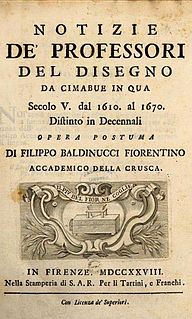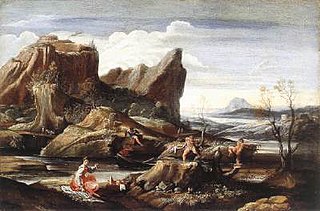
Joachim von Sandrart was a German Baroque art-historian and painter, active in Amsterdam during the Dutch Golden Age. He is most significant for his collection of biographies of Dutch and German artists the Teutsche Academie, published between 1675 and 1680.

Adriaen Pietersz van de Venne, was a versatile Dutch Golden Age painter of allegories, genre subjects, and portraits, as well as a miniaturist, book illustrator, designer of political satires, and versifier.

Jacob de Heusch, was a Dutch painter. He was Willem de Heusch's nephew, signing like his uncle, substituting an initial J for the initial G.

Otto Marseus van Schrieck was a painter in the Dutch Golden Age. He is best known for his paintings of forest flora and fauna.

Filippo Baldinucci's Notizie de' Professori del Disegno, Da Cimabue in qua, Secolo V. dal 1610. al 1670. Distinto in Decennali was a major art biography of Baroque painters. Written by the erudite Florentine professor of the Accademia della Crusca, it is often verbose and rife with factual errors; however, it is a broad compendium of stories about generally contemporaneous Baroque painters.

Jan Gerritsz van Bronckhorst was a Dutch Golden Age painter and engraver. He is considered today to be a minor member of the Utrecht Caravaggisti.

Adriaen van Nieulandt was a Dutch painter, draughtsman and engraver of the Baroque period.

Gaspar de Witte was a Flemish painter who is known for his landscapes and gallery paintings.

Daniel Seiter, Saiter, or Seyter (c.1642/1647–1705) was a Viennese-born painter of the Baroque, who trained and worked in Italy.

Anthoni Schoonjans, nicknamed Parhasius was a Flemish painter known for his portraits as well as his history paintings. After training in Antwerp he had an international career, which saw him work in various countries in Europe including France, Italy, Germany, Austria, The Dutch Republic and Denmark. He was a court painter in Vienna, Copenhagen, Berlin and Düsseldorf.

Pieter de Molijn was a Dutch Golden Age painter and engraver of English birth and Flemish descent.

Nikolaus Knüpfer was a Dutch Golden Age painter.

Willem or Guiliam van Nieulandt, sometimes Nieuwelandt (1584–1635) was a Dutch Golden Age painter, engraver, poet and playwright from Antwerp.

JoannesMeyssens, was a Flemish Baroque painter, engraver, and print publisher.

Willem Doudijns (1630–1697), was a Dutch Golden Age painter and engraver.
Jan van Bunnik (1654–1727) was a Dutch Golden Age landscape painter.
Jacobus de Baen, was a Dutch Golden Age portrait painter who was the son of Jan de Baen.

Jacques Vaillant, was a Dutch Golden Age painter.

Melchior Küsel was a German engraver.

The Great Theatre of Dutch Painters and Paintresses, or De groote schouburgh der Nederlantsche konstschilders en schilderessen, as it was originally known in Dutch, is a series of artist biographies with engraved portraits written by the 18th-century painter Arnold Houbraken. It was published in three volumes as a sequel to Karel van Mander's own list of biographies known as the Schilder-boeck. The first volume appeared in 1718, and was followed by the second volume in 1719, the year Houbraken died. The third and last volume was published posthumously by Houbraken's wife and children in 1721. This work is considered to be a very important source of information on 17th-century artists of the Netherlands. The Schouburg is listed as one of the 1000 most important works in the Canon of Dutch Literature from the Middle Ages to today.



















